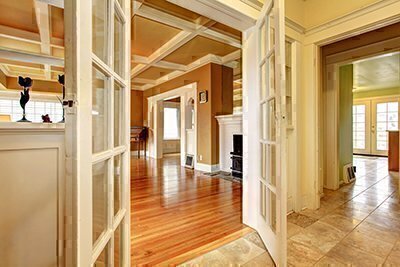How to Judge Remodeling Work
Last updated December 2021
As your job progresses, look for these signs of quality.
Windows and doors should be solid and open and close smoothly. Improper installation, not the products themselves, is usually the cause of sticky windows or leaky entry doors.
 Interior doors should fit closely at the bottom, just touching the carpet nap, and have stops.
Interior doors should fit closely at the bottom, just touching the carpet nap, and have stops.
Floors and steps shouldn’t bounce or give when you walk on them. They shouldn’t creak, either.
Look at the drywall. Can you see nail “pops?” Are the seams obvious?
Basements and crawl spaces should be dry and show no evidence of moisture. Small cracks in foundation walls are okay; larger vertical cracks are not.
Check out wood molding, crown molding, and other trimwork for tight seaming. Joints should be securely mitered.
Check for drafts around windows and doors, and around joints where the floor and wall and ceiling and wall come together.
Kitchen cabinets should be screwed to the wall, not nailed. Cabinet doors and drawers should open and close smoothly.
Take a close look at installed surfaces, including countertops and backsplashes. Are they solid, level, and free of marks and other damage?
Check faucets. They should operate easily and at all speeds and temperatures.
Look for proper bracketing on bookshelves and hanging rods in closets. Brackets should appear every four feet on shelves, every five feet on rods. Also, contractors often forget to fully finish spaces like closets and pantries. Check to make sure they’re built out, per the plan, and fully painted and trimmed.
Is the toilet tight (not wobbly), the tub completely caulked, the showerhead secured, the tile work adequately grouted, and faucets on straight?
It’s easy to bungle the installation of ventilating fans. They should hum quietly, not shake or rattle.
Installers frequently rush to hang accessories like mirrors, medicine cabinets, towel bars and rings, and toilet-paper holders. Check that they are level and hung solidly.
Look for light switches and outlets. Are they conveniently placed or in odd spots? Outlets should appear every 10 to 12 linear feet.
Also, look for GFCI outlets in kitchens and baths.
Long lengths go into the best wood floors—not short pieces or a combination of short and long. Joints should be tight, with little space between boards. Look for shoe molding at the intersection of wall and floor.
Tile floors are prone to damage during installation. Check for cracked pieces; also make sure grouting is seamless.
Does the grade for an addition slope away from the house? Do you see splash blocks near downspouts?
Are gutters and leaders connected and undamaged?
Are the siding and trim undamaged and tightly jointed? Wood siding and trim should be a minimum of eight inches off the ground.
Do painting and staining look uniform?
Does brick or masonry look washed down? Have excess mortar and other residue been cleaned off?
Is the caulking around windows and doors smooth and unbroken?
At spots where roofing meets other materials, flashing should be obvious and tightly installed.
New shrubbery should be planted two to three feet from the foundation.


